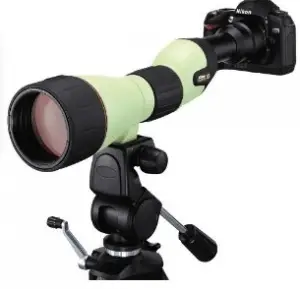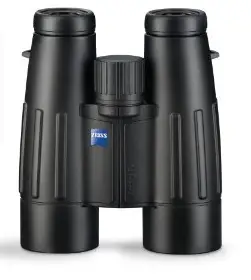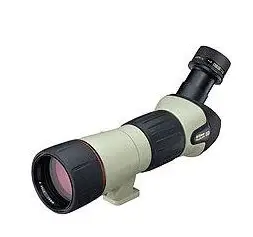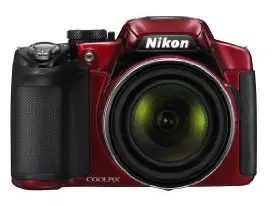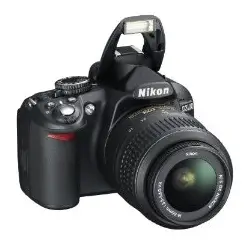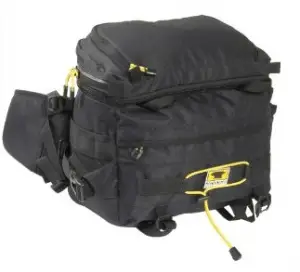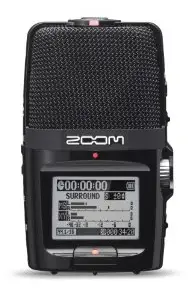Binoculars
I discovered as a new birder that I have very close interpupillary distance, which for a birder means that you need to work pretty hard to find a pair of binoculars where you can get the two barrels close enough that you’re not seeing double.
Thankfully the Zeiss Victory FL has solved that problem quite well for me!
I love these bins. They’re not too heavy. They’ve got a 6 foot close focus, which is great for seeing the butterflies at your feet, they’re bright, and they make watching birds a pure and utter joy. Don’t leave home without them.
Spotting Scope, Tripod, and Digiscoping Adapter
My spotting scope is Nikon Fieldscope 82mm with a 25 x – 75 x zoom eyepiece. This scope has been with me to witness the Veracruz River of Raptors, in the Florida Everglades and out to the Dry Tortugas, up and down the Grand Canyon, all over the state of Maine, and so many other grand birding adventures.
For many years now it has been my constant birding companion, and I am so grateful for its tough ruggedness. I even dropped it once, and was so relieved that nothing was broken!
Right now I have a Giottos Carbon Fiber Tripod with a Giottos Quick Release 3-way pan head. While this is rugged and sturdy, I have to admit that it’s heavy. After a day of birding and hiking some rocky trails, my shoulders get really sore. Plus, it’s too long to fit into my carry-on luggage, which means I have to check it. If you’ve ever seen the way baggage gets handled at the airport, subjecting a piece of really important equipment to that treatment is not an ideal situation!
So, I’m saving my pennies to get a lighter model. Until then, this set-up has served me well so far.
Now if you know me, you know that getting decent photos of all the beautiful birds I see is a particular passion of mine. Since I’m already carrying a spotting scope the idea of carrying a large camera lens in addition isn’t very appealing.
Fortunately, Nikon makes a digiscoping adapter that allows me to connect my Nikon DSLR body to my scope, and I’ve gotten some wonderful close-up photos of some stunning birds this way!
I just unscrew the eyepiece, attach the adapter to my camera body, and screw it into the eyepiece connector. Easy peasy.
Cameras
Some wise person once said that the best camera for the job is the one you have with you. I have been thrilled with the quality of the many photos and videos I’ve taken with my iPhone (the camera that’s always in my pocket).
It’s amazing how many times I’ve gotten the shot because I could whip out my phone in a hurry and get a few photos off in the excitement of the moment.
And I’m not alone in recognizing the power of the iPhone for bird photography. This year has seen an explosion of attachments: iPhone to binoculars adapters, iPhone to spotting scope adapters, and some amazing apps to help you make your photos shine.
The camera that I choose most often for birding adventures is the Nikon P510, with its amazing 42 x zoom.
This little lightweight dynamo has the equivalent of a 1000 mm lens, and yet it weighs only about a pound. Nikon describes it this way:
For the outdoor photographer, the Nikon COOLPIX P510 puts you where you need to be. Bring your subjects up close and personal, with an incredible 42x optical zoom (24-1,000mm). Spontaneous action is captured sharp and clear with optical VR Image Stabilization and amazingly fast autofocus. Every image and Full HD 1080p movie dazzles when produced by the advanced 16.1 MP CMOS sensor. The P510 also boasts a variety features such as built-in GPS and geotagging, high-speed continuous shooting (5 FPS), 3-inch Vari-angle LCD monitor, 20 pre-programmed scene modes, wide panorama mode, 3D viewing and much more!
Now I may have started out as a birder, but nature is so amazing and there’s just so much to learn about: butterflies, dragonflies, native bees, and all manner of tiny little critters. To photograph these bugs, and for close-ups of flowers, nothing beats a good macro lens!
For this purpose I have a Nikon D3100 DSLR and a Nikon 85 mm AF-S DX ED VR Micro Nikkor Lens. The reason that I chose this camera body is that I am unable to carry heavy equipment for long periods of time due to an auto accident in which I broke my neck, and every extra ounce of weight that I carry for long excursions can contribute to some ongoing chronic pain. The Nikon D3100 is very lightweight and doesn’t add significantly to my load. (And for this reason, I don’t always carry my spotting scope either).
The 85mm Micro lens is amazing! Looking at a butterfly’s antenna, a dragonfly’s wing, or a bee’s eye in intricate detail is incredible. And I can do it with this lens.
And, I needed to find a way to carry my cameras in a way that didn’t hurt me. I had tried a sling bag because I love that it was so easy to swing it forward to get what I needed, then swing it back around so it was on my back. There’s two problems with this bag though: 1 is that these bags are designed for men, but don’t really work well with a woman’s anatomy, and 2 all the weight was on one shoulder and did not evenly distribute the weight.
The bag that I’ve found that works best for me is the Mountainsmith Tour FX Lumbar Camera Bag (it’s even made of recycled materials!) with the optional Strapettes (which make backpack straps).
I wear it as a lumbar bag with the waist strap and also the backpack straps, which distributes the weight across my hips and shoulders. When I need something, I slide the backpack straps off and spin the bag around to the front, giving me access to everything I need without taking the bag off. And this set-up has been working quite well so far.
Other Gear
I like to do audio interviews with birding guides, conservationists, and other experts while I’m traveling, which I produce as podcasts to share important information with you. I love learning from local experts and sharing their ideas in their own voice is a wonderful way to learn about new places.
My favorite voice recorder is the Zoom H2n, which runs on 2 AAA batteries and used SD cards as flash memory, so I am never worried about filling up the memory in the middle of the day. I just carry a few extra SD cards with me, so that I always have more recording space.
This is also a great way to get better sound than I can capture with my cameras when shooting video. The mic on the iPhone is not great, and while both other cameras shoot video the sound isn’t always the best with them either. I can grab the sound using the Zoom, and then add this better quality audio to the video when I’m editing. The difference is amazing!
When I travel, I like to go as light as possible, so lugging my Macbook Pro is not my idea of fun (plus I’m always worried something will happen to it like getting dropped or something, and I can’t afford to have it get damaged because it’s how I make my living), so my iPad has become an indispensable tool.
I can edit photos, create blog posts, manage comments and other business at my blogs, and even keep up with my email (that’s really important, since most days I get over 500 emails a day, so even a long weekend away means that my inbox will be an overwhelming black hole if I don’t keep up with this. The “delete” key is my friend, LOL).
There are so many things that can be accomplished on my iPad, I can’t even imagine what I did before I had one. Actually, I never would have thought I needed one until I went to take care of my mom in Florida before she passed away. I knew I’d be spending long days in the hospital with not a lot of room to spread out, so I picked my iPad up before I left to become her caretaker. And much to my surprise, it really is a most useful tool!

